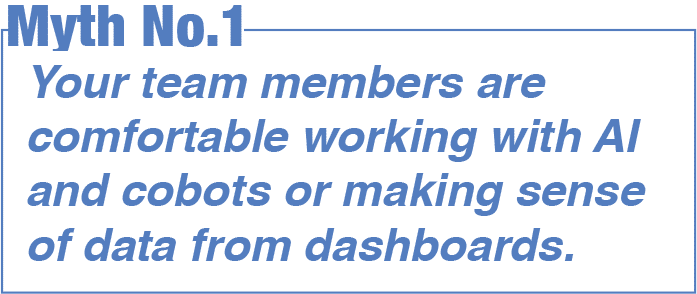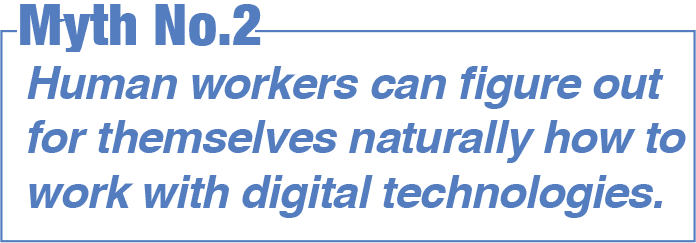HUMANISED PRODUCTION WILL BE YOUR NEXT COMPETITIVE ADVANTAGE

When you think about optimising production processes, utilising digital technologies will be vital for connecting I loT systems and drawing data insights by advanced data analytics or even machine learning. All companies are heading in this direction. However, what not all companies are aware of is – how to guarantee the ultimate success of their entire businesses by considering how humans use these machines or digital applications. Doing so empowers individual workers and therefore empowers companies. It is challenging to make human-machine teams work not only more efficiently but also more happily together. Here, I would like to share some thoughts on how humanised production will be your next competitive advantage. This short piece is based on our close watch of the industry as well as of five EU-funded Horizon 2020 research projects (A4BLUE, Factory2Fit, INCLUSIVE, HUMAN and MANUWORK, 2016-2020).
Yes, you are right. It will still take some time before the entire manufacturing industry fully embraces the 4th Industrial Revolution. Yet we are already headed into the 5th Industrial Revolution – using digital technologies to benefit people and society. To me, it is important to recognise that we cannot wait for Industry 4.0 to be fully implemented before we start to think about Industry 5.0. In fact, if you have recently embarked on digital transformation, then now you must think about converging Industry 5.0 with Industry 4.0. This means designing and operationalising three core elements: human-centricity, sustainability, and resilience in production processes and even in the business value model (I will explain in detail elsewhere). This will allow you to be flexible and adaptable in your future human-machine production processes toward a more sustainable society.
While offering humanised production that may make you a more attractive working environment, what does this actually mean for you at your company? Digital transformation doesn’t mean losing jobs; instead, it means creating more opportunities. Many employees may disagree, however. Myths abound that managers might neglect diverse employees before embracing digital technologies. Below, we identify these myths, and these are followed by some takeaway messages.

No, they are not. Not all of them, not at the same level, and they might not all react comfortably to such developments. Often, the instinct is to suspect or reject these digital technologies — holding pen and paper still feels most reliable. However, to win back the time that is lost in copying information from the paper document to paper document or in printing orders, you must convince people to try out these new tools.
Emotional commitment
Convincing everyone on board is everything but a key start for digital transformation. Getting employees to recognise the true value of digital technologies by onboarding them at different speeds could massively improve production performance. Viewing technologies as competitors or replacements is common. Such instinctive resistance is not inherently related to age, but to mindset. It relates to how mentally ready to embrace such technologies an employee might be and how they view themselves using these technologies at more advanced stages. Map out the emotional commitment to understand these values that exist in your team and across your organisation. Identify the incentives that will help your employees to become willing to try these technologies and adapt their practices.

The reality is that human employees are often not sure about their new roles and new expectations in such human—machine teams. New questions are often raised such as: where are you to locate human beings when humans and machines team up as colleagues?
Helping employees to feel more relevant and that their contributions are valued on top of using machines. It is more than bringing human intelligence back into the loop. It is about augmenting human intelligence with digital technologies so that humans and machines can work together well within a new production norm.
Defining the roles of machines and humans
While managers often worry about how to make the most of human intelligence in human-machine teams, production managers must start paying attention to how the team members in their groups, those in marketing and sales, and even customers will react to such technologies. These processes release humans from repetitive work and empower them to be responsible for more valuable work such as reducing production incidents. Shopfloors never lack emergent moments that need human’s thinking outside of the box. Human workers’ years’ experiences, intuition, and insights cannot be replaced by the analytical capabilities of Al applications. Imagine a situation in which shopfloor operators no longer need to worry about making mistakes when reading notes from the previous midnight shift. Using smartphones to receive notifications when needed can save time and energy. Imagine a production manager who can understand the matrix of machine downtime and so predictable on-demand supply will become manageable. Imagine a sales department that has access to live production data and can give promises to clients upon which they can deliver.

Human workers may need a long-term incentive to gain a strong sense of belonging. The new value they contribute needs to be recognised in the production process.
Empower humans by digital competence
It is essential to recognise the value that humans add to these new production processes. The growing value is variable and will be improved by the digital competence scheme. As mentioned earlier, mapping differing reactions to these technologies, the digital competence will take effect when they are customised accordingly. Systematic assessment of physical, cognitive, and psychosocial human factors will guide steps of personal progression along acquisition of digital skills. Approaches such as Operator 4.0 will help managers to understand the working situation and their employees’ capacities within a new complex digital environment. For example, understanding profiles ranging from collocative operators to analytical operators helps managers to customise each employee’s profile to their future training programme. Invite shopfloor operators to be part of decision-making teams and acknowledge their contributions. Other pilot experiments, such as the Factory2Fit project, aim to provide a dashboard for shopfloor operators to help them understand their well-being and work performance both between and during work shifts.
Investing in your employees will enable them to work happily and attract future talent. Through this, employees will become motivated, driven and on a mission to learn new skills they need in the future. Digital transformation can benefit individual employees in this way where the company eventually flourishes.